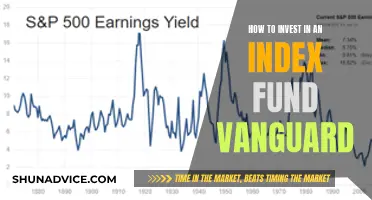
A contingency fund is a safety net to cover unexpected expenses in personal finance, business, and government. It is a dedicated reserve of money set aside to handle unforeseen costs and emergencies, ensuring financial stability and peace of mind. When deciding where to keep a contingency fund, it's important to balance easy access with the potential for growth. High-yield savings accounts are a great option, offering better interest rates than standard savings accounts while keeping your money readily available for emergencies. Money market accounts are another solid choice, often providing higher interest rates along with easy access. For those who can afford to lock away a portion of their fund for a short period, short-term certificates of deposit (CDs) offer higher returns with minimal risk.
What You'll Learn

High-yield savings accounts
Pros:
- High-yield savings accounts offer significantly higher interest rates than traditional savings accounts, often around 5% APY.
- Your money is easily accessible, as most accounts provide online and mobile banking services.
- There are usually no monthly service charges, and many accounts have low or no minimum balance requirements.
- Your deposits are insured by the FDIC or NCUA, ensuring your funds are protected up to $250,000.
Cons:
- Interest rates on these accounts are variable and can change at any time.
- Some accounts impose monthly withdrawal or transfer limits, and not all accounts offer ATM cards.
- Most high-yield savings accounts are online-only, so there may be limited to no in-person banking options.
- Transferring funds between accounts can take some time, usually 24 to 48 hours.
When choosing a high-yield savings account, consider the APY, minimum balance or deposit requirements, fees, and the level of access you need to your funds. It's also important to note that while your money can grow faster in these accounts, they may not be the best option for long-term wealth growth, as inflation can outpace the interest earned over time.
Best Funds to Invest in: Where to Start?
You may want to see also

Money market accounts
Higher Interest Rates
Easy Access to Funds
Safety and Security
Check-Writing Privileges
Some money market accounts offer check-writing privileges, providing added flexibility in accessing your funds. This feature allows you to write checks directly from your money market account, making it convenient to pay for unexpected expenses or transfer funds as needed.
Low Minimum Balance Requirements
Online and Mobile Access
Many money market accounts offer online and mobile banking capabilities, providing you with convenient access to your contingency funds anytime, anywhere. This digital accessibility enables you to monitor your balance, transfer funds, and manage your savings on the go, giving you greater control over your emergency savings.
Fund Setter: Minimum Investment Requirements and More
You may want to see also

Short-term certificates of deposit (CDs)
When it comes to short-term CDs, you can find options with terms ranging from 3 months to 1 year. This means that you agree to keep your money in the CD for that specified period, and in return, you'll earn a higher interest rate compared to a traditional savings account. The early withdrawal of funds usually results in a penalty, so it's important to consider your investment horizon before choosing a CD term.
CDs are considered a safe and conservative investment option, as they are FDIC-insured up to $250,000. This means that your funds are protected even if the bank or credit union fails. Additionally, CDs offer a fixed and guaranteed rate, so you know exactly how much you'll earn over the term.
When choosing a short-term CD, it's important to compare rates from different banks and credit unions. The APY (Annual Percentage Yield) can vary across institutions, so shopping around can help you find the best rate. Some banks may also offer specialty CDs, such as bump-up CDs or flexible CDs, which can provide more flexibility.
It's worth noting that CDs may not be suitable for everyone. The fixed-rate nature of CDs can be a disadvantage if interest rates rise during the term, as you could miss out on higher returns. Additionally, your money is locked in, and early withdrawal penalties can be high. However, for those looking for a safe and predictable investment option for their contingency funds, short-term CDs can be a great choice.
IRA Investment Strategies: Where to Invest for Maximum Returns
You may want to see also

Short-term debt funds
When it comes to returns, short-term debt funds have delivered better returns than bank fixed deposits while keeping the risk under control. They provide stable returns as they have a moderate interest rate risk. Additionally, these funds offer the advantage of dividend income and capital gains. Dividends are taxed according to the investor's tax bracket, while capital gains are taxed based on the length of time the units are held before sale or redemption.
Some popular short-term debt funds include HDFC Short Term Debt Fund, ICICI Prudential Short Term Fund, and SBI Short Term Debt Fund. These funds have delivered strong returns over the years and are considered a good option for a 1-2 year investment period.
College Fund: When to Shift to Safer Investments?
You may want to see also

Flexi deposits of banks
A flexi fixed deposit is a special type of deposit offered by banks in India and other countries. It combines the features of a demand deposit and a fixed deposit, allowing customers to enjoy the liquidity of a savings or current account with the high returns of a fixed deposit. This type of account is ideal for those looking to build a contingency fund, as it provides both flexibility and competitive interest rates.
One of the key features of a flexi fixed deposit is the "auto-sweep" function, which automatically transfers any excess balance above a stipulated amount to a fixed deposit account for a default term of one year. This allows customers to grow their savings without having to actively manage their accounts. Additionally, flexi fixed deposits offer flexible tenure options, allowing customers to select a tenure that aligns with their financial objectives.
When it comes to investment amounts, flexi fixed deposits offer flexibility as well. Customers can choose the investment amount based on their current holdings or their desired corpus at the end of the tenure. This makes it easier for customers to build their savings at their own pace. Furthermore, flexi fixed deposits often come with a premature withdrawal feature, providing liquidity to depositors. However, it's important to note that the specific rules and regulations regarding premature withdrawals may vary from bank to bank.
Another advantage of flexi fixed deposits is the loan facility that comes with them. Customers can use their flexi fixed deposit as collateral to avail of a loan from the bank. This can be especially useful in case of unexpected expenses or financial emergencies. However, it's important for customers to be aware of their bank's policies and any associated terms and conditions.
In terms of interest rates, flexi fixed deposits typically provide higher interest rates than savings accounts, enabling customers to create a larger corpus over time. Additionally, the minimum deposit amounts required to open a flexi fixed deposit account are generally affordable, with some banks requiring as little as Rs.1,000 while others may require higher amounts.
Overall, flexi fixed deposits offered by banks provide a flexible and attractive option for those looking to build their contingency funds. With features like auto-sweep, flexible tenure, competitive interest rates, and premature withdrawal options, customers can enjoy both the liquidity and the high returns offered by this type of account.
Private Equity Funds: Impact Investing Strategies Revealed
You may want to see also
Frequently asked questions
A contingency fund is a monetary safety net to cover unexpected expenses in personal finance, business, and government. It helps to avoid debt, protect savings, and provide flexibility to seize opportunities or handle emergencies.
A contingency fund acts as a cushion against unexpected disruptions, keeping finances stable and secure. It helps individuals and businesses avoid debt and protect their savings. For businesses, it also helps to maintain operations during financial challenges. For governments, it ensures public service continuity in times of crisis.
First, set a target amount based on your expenses and financial situation. Then, create a budget by allocating a portion of your income specifically for your contingency fund. Finally, automate your savings by setting up regular transfers to your fund. It's important to balance easy access to your fund with potential growth, so consider high-yield savings accounts or money market accounts.







